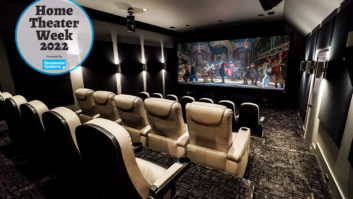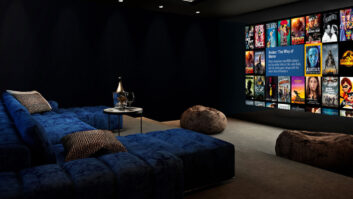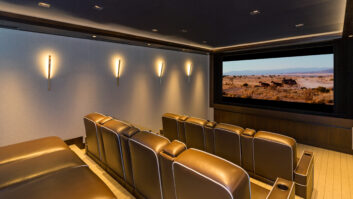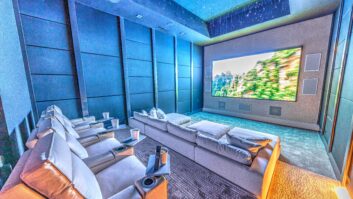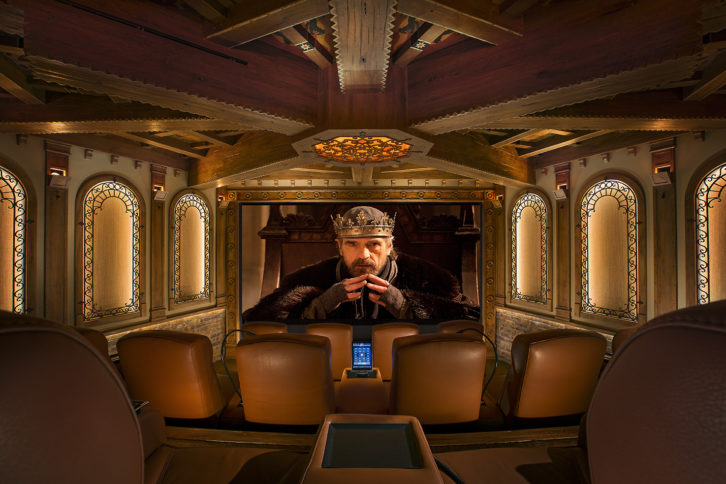
As design and technology continue to intersect throughout the smart home, home theaters are feeling the impact perhaps harder than other spaces. It’s time to embrace the notion that design and tech go hand-in-hand on home theater projects. You’ve adapted to technological innovation in networking, lighting, automation, security, and other home tech segments. It’s helped shape your business, exposing new opportunities for growth along the way. Similarly, by adding a strong design influence into your home theater repertoire, you can expand your business even further, and the timing couldn’t be better.
Big Business Opportunities
Home theater is experiencing a surge of homeowner interest. Commercial cinemas are either closed or offering limited seating, so many families are actively exploring new ways to stay engaged and entertained at home. They’re also spending more money than ever on home renovations. According to a poll of 1054 Americans by Bank of America about their attitudes and shopping habits during the coronavirus pandemic, more than 70 percent have decided to tackle home improvement projects, with more planned for 2021. These two trends alone should be a strong enough impetus to revisit and revamp your home theater offerings to bring consumers exactly what they want now — an experience that’s as close to a cinema as possible that serves as an escape from the stress and uncertainty of the world we live in today.
Naturally, having a solid staple of quality home theater products is imperative to home theater mastery, but having a handle on the design is just as important. Yes, I said design. The two — technology and design — simply cannot exist without the other, especially when creating the caliber of home theater consumers want today. Design is what ultimately draws your customers to home theater. They want an entertainment space that transports them to another dimension the second they walk in; they want a room with a huge wow factor and something to show off to their friends and family. Design accomplishes all of these objectives. It creates an environment that’s special even when the AV is off. Why make your customers wait until the projector is fired up to feel great about the space they’ve invested in? Design does this in an instant and gives your customers a space they want to come back to time and again.
By allowing design to set the tone for your theaters, they will possess all the necessary components to excite your customers, elevate your business, and create avenues of opportunity.
Also by Lisa Slayman: Top 10 Home Theater Design Trends
Pro Tips
Here are some tips to help you become more design savvy in your home theater endeavors:
Recognize That Theater Design Blends Art and Science. There’s an art that goes into the design of a home theater that extends way beyond choosing colors and fabrics. This is the role of a typical interior designer. A home theater designer brings a lot more to the table. While a home theater designer certainly strives to create visually stunning spaces, they actually place more emphasis on the performance of the AV equipment than anything else. The goal of their designs is to enable the components you specify and install to operate optimally. For example, they understand that there’s a strong relationship between room dimensions and the audio quality of a Dolby Atmos system; the sightlines and the screen size, and the wall texture and the room acoustics. One hand feeds the other, so to speak, and by collaborating with a professional who specializes in home theater design, you can ensure that your clients’ expectations are not only met, but surpassed.
Also by Lisa Slayman: Case Study – Innovative Design and AV Unite to Solve Seating Dilemma
Home Theater Artistry: Build Your “A” Team. There’s no reason you need to become an expert at home theater design. Just know that it’s important and there are professionals who can handle this aspect of the project. It’s no different than the acoustician who applies his knowledge of sound vibration, propagation, and isolation to engineer and room in which an audio system can perform optimally, or the lighting designer who specifies the appropriate fixtures, lighting levels, and placement to visually enhance the space without detracting from the AV presentation. A home theater designer, meanwhile, understands how finishes and furnishings, dimension and space, and even construction materials can be designed in a manner that allows your technology to shine within a beautiful, comfortable, one-of-a-kind entertainment environment.
Use Design to Excite Your Customers. Accept that consumers are often drawn to the design of a home theater more so than the AV technology. The first thing they notice in renderings or photography of theaters is typically the design, and that’s okay. Use this to your advantage. Let a home theater designer create a space that “speaks” to your clients, whether that’s contemporary, Art Deco, traditional, or Hollywood glamour — and collaborate closely with everyone involved.
No Disappearing Act. It’s a common misconception that home theater designers abhor technology, that they do everything in their power to hide it. “We often find that the interior designer doesn’t know just how creative they can be with AV. They typically just want the technology to disappear, but when they discover the possibilities and learn that speakers and other technology can be customized to match their design, we see the lightbulb go off,” comments Noah Kaplan, president of Leon Speakers.
Related: Sound with Style
This lightbulb for many home theater designers has been burning brightly for many years, so, as suggested before, collaborate only with an “A-Team” caliber of designer to ensure smooth collaboration and that the design works with your AV plans, not against it.
Lisa Slayman, ASID, IIDA is president of Slayman Cinema.
Design Insights
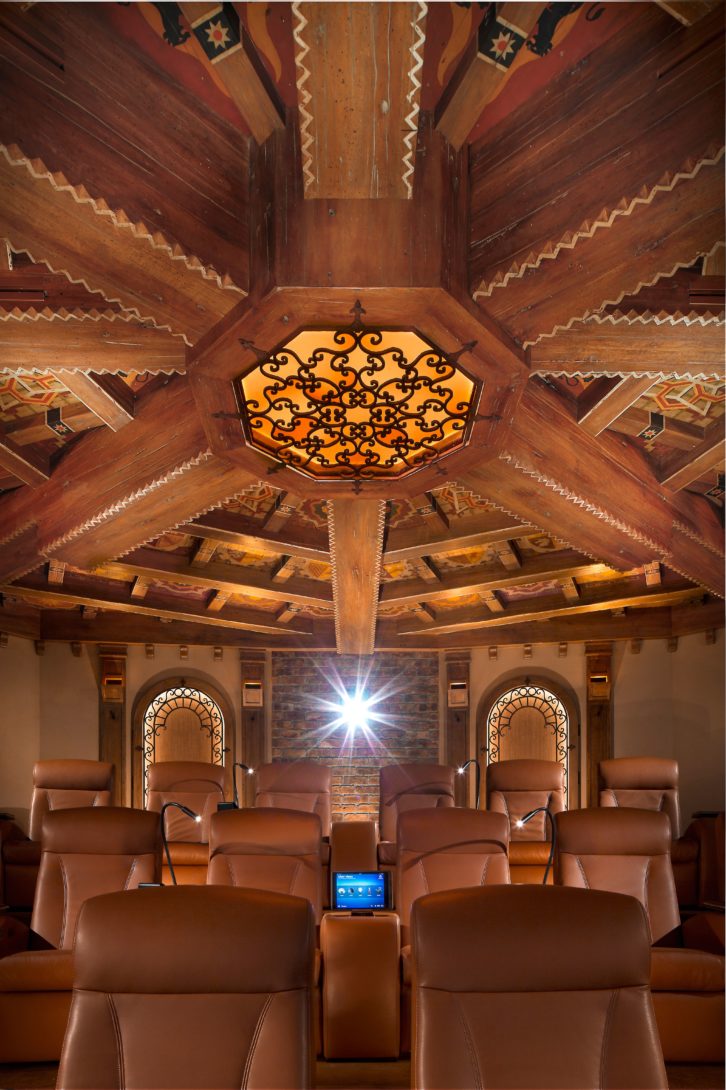
- Most consumers want their home theaters to be a special destination, and this means departing slightly from the design of the rest of the house. It shouldn’t look like any other room, but something amazing with “over the top” details you won’t find anywhere else.
- Don’t’ forget about the ceiling. It’s the perfect focal point, visually drawing the eye away from the walls and providing eye candy from all angles when nothing is on the screen.
- Incorporate some design vernacular into your vocabulary — traditional, contemporary, modern, etc. — and have a basic understanding of the elements of each [see the “Multiple Home Theater Personalities” sidebar].
- Identify how and who will be using the theater. Home theaters have become places in which to escape. Some people escape with concert videos, others with solitary mediation, and some crave a good old-fashioned action blockbuster to get away from it all. The how and who will influence the design and tech choices and implementation.
Multiple Home Theater Personalities
When clients request a home theater, they want the designer to create a space that’s amazing to look at and comfortable to spend time in. If they’d rather sink into a soft couch than a traditional theater seat, that’s okay. It’s also okay if they prefer neutral tones over vibrant reds and blues. Maybe they like having cocktails and snacks during shows and could benefit from having a bar at the back of the theater.
It’s the job of the home theater designer to help direct them in their selection of furniture, colors, and other elements. It’s also a home theater designer’s job to recognize and resolve any conflicts these materials, hues, textures, and room layouts can have on the AV performance. Here are a few common home theater designs that you’ll likely run across, along with their signature features so you can address any potential AV conflicts with your home theater designer:
Traditional: Large, ornate moldings and columns of various finishes, formal draperies, and elaborate prosceniums are a few of the design components you’ll see in a traditionally styled theater.
Contemporary: Clean lines, angular lines; geometric patterns; indirect lighting; and a combination of natural materials of wood, stone and metal signify the style of a contemporary home theater.
Art Deco: A throwback of the grandeur of the 1920s, Art Deco-inspired home theaters feature strong symmetry and layered shapes, along with luxurious accouterments like illuminated movie marques.

